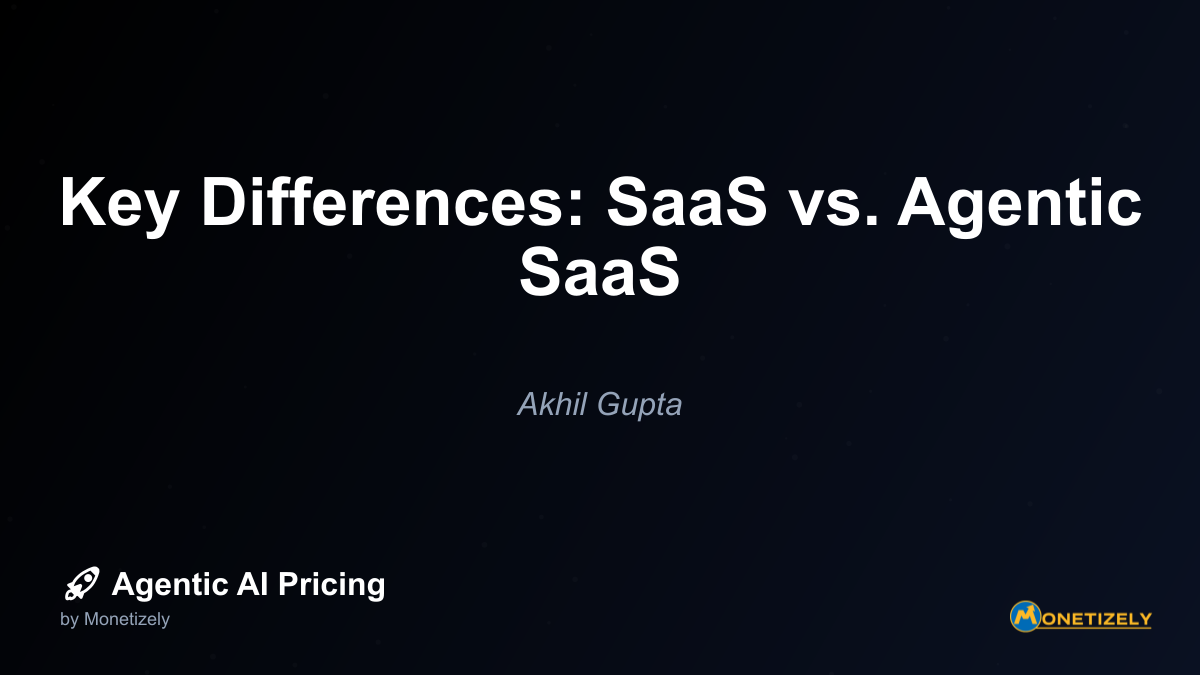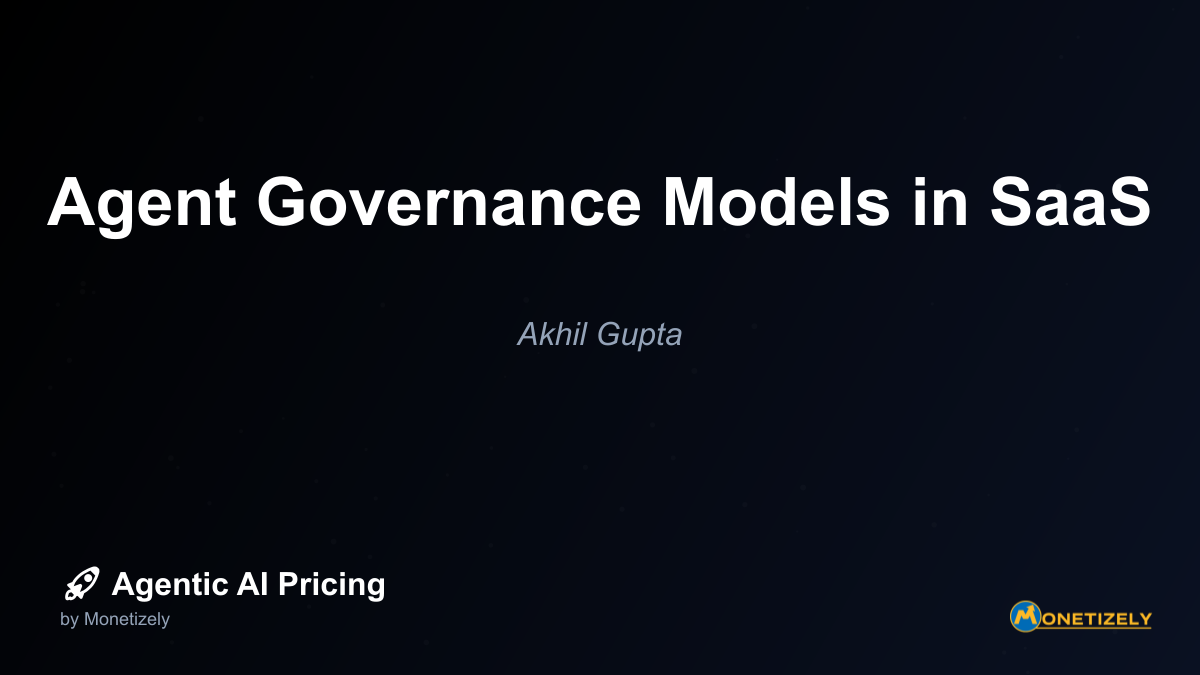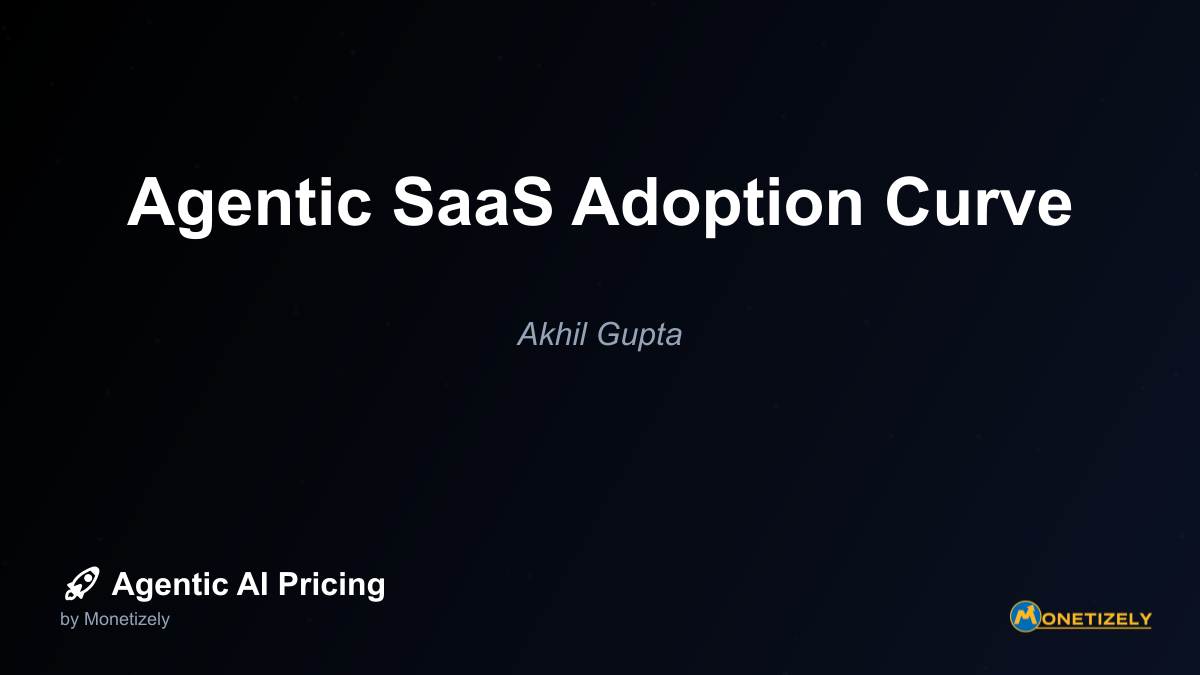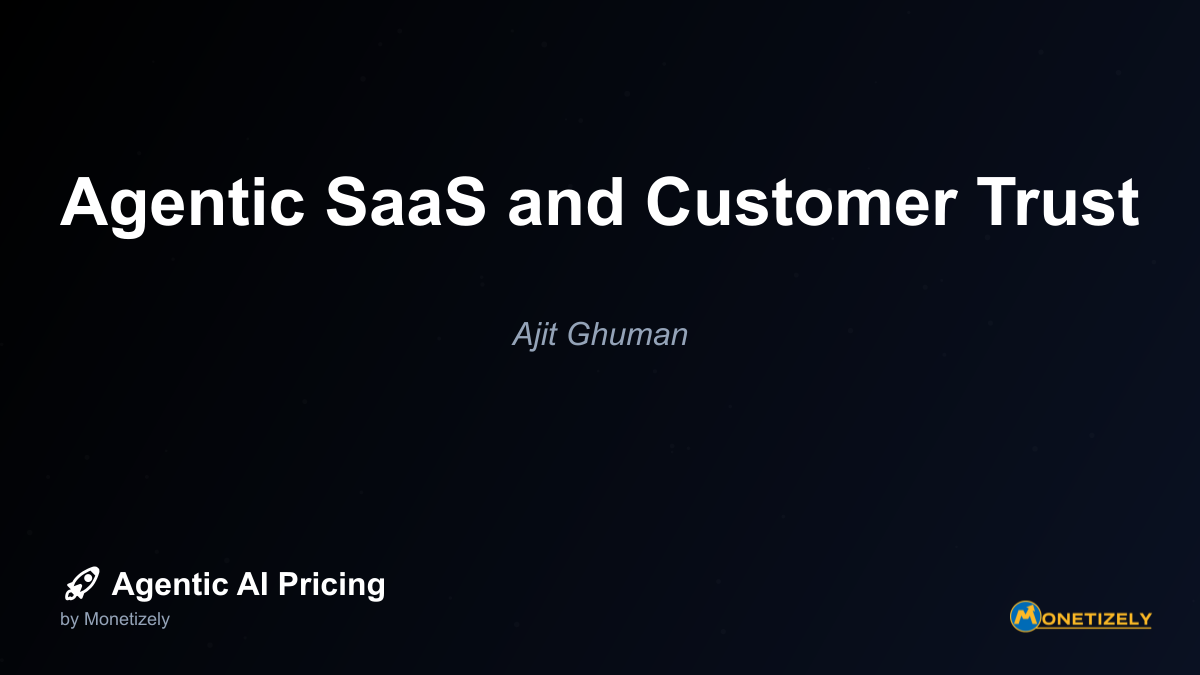· Akhil Gupta · Agentic SaaS Fundamentals · 9 min read
Agentic SaaS Foundations Recap
AI and SaaS Pricing Masterclass
Learn the art of strategic pricing directly from industry experts. Our comprehensive course provides frameworks and methodologies for optimizing your pricing strategy in the evolving AI landscape. Earn a professional certification that can be imported directly to your LinkedIn profile.
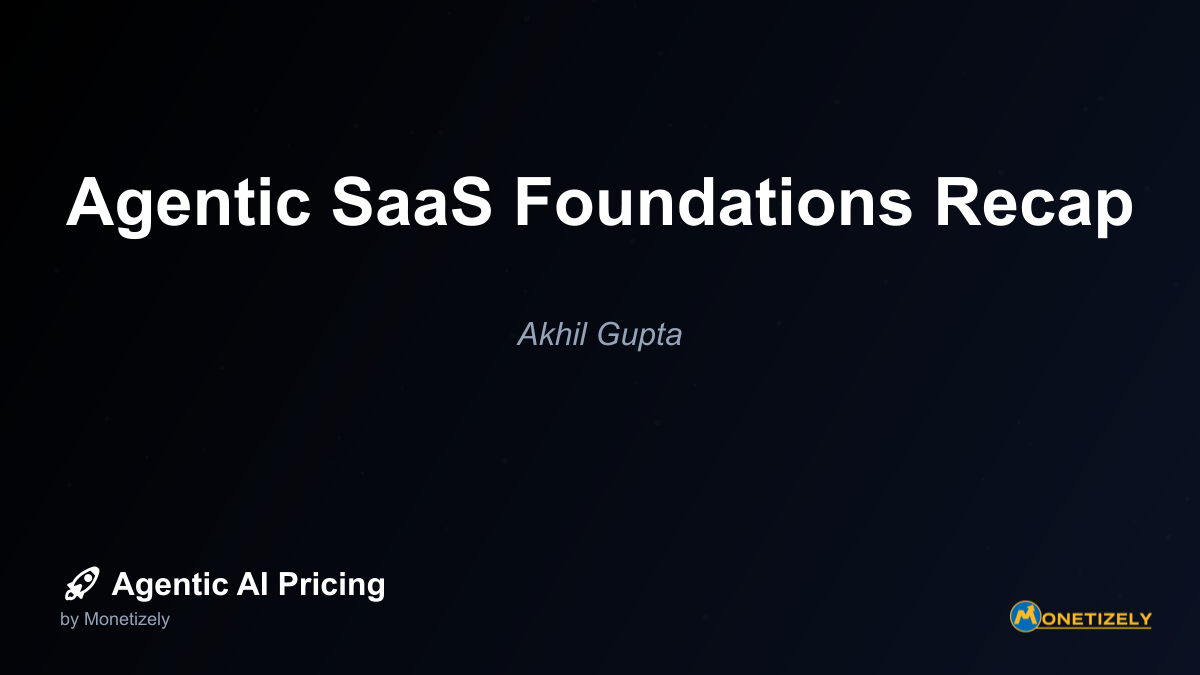
Key Pricing Models for Agentic SaaS
The unique capabilities of agentic SaaS necessitate innovative pricing approaches that differ significantly from traditional software pricing models. Through our exploration, we’ve identified several predominant pricing frameworks specifically suited to the agentic SaaS landscape:
Value-Based Pricing
Value-based pricing aligns costs directly with the measurable business outcomes delivered by the agentic solution. This approach requires:
- Value Quantification: Establishing concrete metrics that demonstrate the solution’s impact
- Outcome Measurement: Implementing systems to track and verify results
- Risk-Sharing Mechanisms: Creating pricing structures where vendor compensation increases with customer success
For example, an agentic sales enablement platform might charge based on percentage of incremental revenue generated rather than a flat subscription fee. This model creates perfect alignment between vendor and customer interests.
As explored in our Agentic SaaS Pricing Techniques Playbook, value-based approaches often yield the highest long-term revenue while creating the strongest customer relationships.
Usage-Based Pricing
Usage-based models charge customers based on their consumption of specific resources or activities within the agentic system. Key considerations include:
- Resource Identification: Determining which aspects of usage correlate with value
- Scaling Mechanisms: Creating tiers or volume discounts that reward increased adoption
- Transparency Tools: Providing customers visibility into their usage patterns
An agentic data analysis platform might charge based on the number of data points processed or insights generated, scaling costs with the complexity and volume of work performed by the autonomous system.
Hybrid Pricing Structures
Many successful agentic SaaS providers implement hybrid models that combine multiple pricing approaches:
- Base + Variable: A foundation subscription plus outcome-based components
- Tiered + Consumption: Predefined service tiers with usage-based add-ons
- Freemium + Premium: Free basic autonomous capabilities with paid advanced features
These hybrid approaches provide stability for vendors while offering flexibility to customers with diverse needs and usage patterns.
The Technical Infrastructure of Agentic SaaS
The pricing models of agentic SaaS are intricately tied to the underlying technical architecture that enables autonomous operation. Understanding these technical foundations is crucial for developing pricing strategies that accurately reflect resource consumption and value creation.
AI Decision Frameworks
At the core of agentic SaaS lies sophisticated AI decision-making systems that enable autonomous operation:
- Machine Learning Models: Trained systems that learn from data to make predictions or decisions
- Neural Networks: Deep learning architectures that mimic human cognitive processes
- Reinforcement Learning: Systems that improve through trial and error in dynamic environments
The complexity and sophistication of these AI components directly impact both the development costs and the value delivered to customers, making them critical factors in pricing strategy development.
Data Processing Capabilities
Agentic systems require robust data processing infrastructure:
- Real-Time Analytics: Processing information as it arrives to enable immediate action
- Large-Scale Storage: Managing vast datasets that inform AI decision-making
- Integration Frameworks: Connecting to diverse data sources across customer environments
The scale and performance of these data systems often determine the operational costs of delivering agentic services, creating a direct link between technical infrastructure and pricing model design.
Execution Mechanisms
The ability to take action based on AI decisions requires specialized execution systems:
- API Integration Networks: Connections to external systems for implementing decisions
- Workflow Automation: Processes for coordinating multiple actions across systems
- Feedback Loops: Mechanisms for evaluating outcomes and refining future actions
These execution capabilities represent a significant portion of the value delivered by agentic systems, as they translate intelligence into tangible business outcomes.
Business Model Implications of Agentic SaaS
The transition to agentic SaaS fundamentally transforms business models for both providers and customers, creating new challenges and opportunities in the software marketplace.
Revenue Recognition Challenges
The autonomous nature of agentic systems creates unique revenue recognition considerations:
- Continuous Value Delivery: Unlike traditional software with discrete usage events, agentic systems provide ongoing value
- Outcome Measurement Timing: Results may materialize well after the service is delivered
- Performance Attribution: Determining how much business improvement came from the agentic system versus other factors
These challenges require sophisticated accounting approaches and clear contractual frameworks to ensure proper revenue recognition while maintaining compliance with financial reporting standards.
Customer Success Evolution
The role of customer success teams changes dramatically in the agentic SaaS model:
- From Usage Support to Outcome Optimization: Focus shifts from helping customers use software to helping them achieve business results
- Proactive Intervention: Identifying opportunities to adjust agentic systems before problems occur
- Value Demonstration: Continuously proving the ROI of autonomous systems through concrete metrics
This evolution requires new skills, tools, and organizational structures within customer success teams, impacting both the cost structure and value proposition of agentic SaaS providers.
Investment Requirements
The capital requirements for agentic SaaS differ substantially from traditional software businesses:
- AI Research and Development: Ongoing investment in improving autonomous capabilities
- Infrastructure Scaling: Building systems that can handle growing computational demands
- Domain Expertise: Acquiring specialized knowledge in customer business processes
These investment needs impact pricing strategies, as providers must balance immediate revenue generation with long-term capability development to remain competitive in the rapidly evolving agentic SaaS landscape.
Implementation Roadmap for Agentic SaaS
Successfully implementing agentic SaaS solutions requires a structured approach that addresses both technical and organizational considerations. Based on our exploration of fundamentals, we’ve developed a comprehensive implementation roadmap:
Assessment Phase
Before deploying agentic solutions, organizations should conduct thorough assessments:
- Process Automation Potential: Identifying which business processes are suitable for autonomous operation
- Data Readiness Evaluation: Determining if necessary data is available and accessible
- Organizational Change Readiness: Assessing cultural and structural preparedness for autonomous systems
This assessment provides the foundation for implementation planning and helps identify potential barriers to success that must be addressed before proceeding.
Pilot Implementation
Successful agentic SaaS adoption typically begins with focused pilot projects:
- Contained Scope: Starting with clearly defined processes and limited stakeholders
- Clear Success Metrics: Establishing concrete measures to evaluate performance
- Rapid Iteration: Building in mechanisms for quick adjustments based on early results
These pilot implementations provide valuable learning opportunities while demonstrating value in a controlled environment, creating momentum for broader adoption.
Scaling Strategy
Expanding from pilots to enterprise-wide implementation requires careful planning:
- Integration Roadmap: Mapping connections between agentic systems and existing infrastructure
- Training and Change Management: Preparing users for new ways of working alongside autonomous systems
- Governance Framework: Establishing oversight mechanisms for autonomous operations
This scaling strategy ensures that initial successes can be replicated across the organization while managing risks associated with broader deployment.
Measuring Success in Agentic SaaS Implementation
Evaluating the effectiveness of agentic SaaS solutions requires multidimensional measurement frameworks that capture both immediate benefits and long-term strategic value.
Performance Metrics
Key performance indicators for agentic SaaS typically include:
- Automation Rate: Percentage of decisions/actions handled without human intervention
- Time Savings: Hours reclaimed from human workers through autonomous operation
- Error Reduction: Decrease in mistakes or inconsistencies compared to manual processes
- Throughput Improvement: Increase in process capacity and speed
These metrics provide concrete evidence of operational improvements delivered by agentic systems, justifying investment and informing pricing decisions.
Business Impact Measures
Beyond operational metrics, successful implementations demonstrate tangible business outcomes:
- Revenue Impact: Increased sales, cross-selling, or customer retention
- Cost Reduction: Decreased operational expenses beyond direct labor savings
- Strategic Advantage: Improved competitive positioning or market responsiveness
- Innovation Acceleration: Faster development and deployment of new capabilities
These business impact measures connect agentic SaaS implementation to core organizational objectives, ensuring alignment between technology investments and strategic goals.
User Experience Evaluation
The human experience of working with autonomous systems represents a critical success factor:
- Adoption Rates: Willingness of users to engage with and rely on agentic systems
- Satisfaction Scores: Perception of value and usability among human collaborators
- Trust Metrics: Confidence in the decisions and actions taken by autonomous systems
These experience measures help identify potential barriers to full value realization and guide improvements in how agentic systems interact with human workers.
Ethical Considerations in Agentic SaaS
The autonomous nature of agentic SaaS introduces unique ethical considerations that must be addressed through thoughtful design, implementation, and governance.
Transparency Requirements
Ensuring stakeholders understand how autonomous systems operate:
- Decision Explanation: Providing clear rationales for actions taken by agentic systems
- Limitation Disclosure: Communicating the boundaries of autonomous capabilities
- Performance Reporting: Sharing comprehensive metrics on system activities and outcomes
These transparency practices build trust while enabling appropriate human oversight of autonomous operations.
Accountability Frameworks
Establishing clear responsibility for autonomous system actions:
- Governance Structures: Defining oversight roles and responsibilities
- Audit Mechanisms: Creating records of system decisions and actions
- Intervention Protocols: Establishing processes for human override when needed
These accountability frameworks ensure that organizations maintain appropriate control over autonomous systems while maximizing their benefits.
Privacy and Data Ethics
Addressing the unique data challenges of autonomous systems:
- Data Minimization: Collecting only information necessary for autonomous operation
- Purpose Limitation: Using data only for intended and disclosed purposes
- Consent Management: Ensuring appropriate permissions for data usage in autonomous contexts
These ethical data practices protect stakeholders while enabling the data-driven intelligence that powers agentic systems.
The Future of Agentic SaaS
As we conclude our exploration of agentic SaaS fundamentals, it’s valuable to consider emerging trends that will shape the evolution of this transformative technology.
Convergence with Other Technologies
Agentic SaaS is increasingly integrating with complementary technologies:
- Internet of Things (IoT): Autonomous systems leveraging real-world sensor data
- Extended Reality (XR): Agentic interfaces operating in immersive environments
- Blockchain: Distributed trust mechanisms for autonomous transactions
These convergence trends will create new capabilities and value propositions, further differentiating agentic SaaS from traditional software models.
Ecosystem Development
The agentic SaaS landscape is evolving from isolated solutions to interconnected ecosystems:
- Agent-to-Agent Collaboration: Autonomous systems working together across organizational boundaries
- Specialized Agent Marketplaces: Platforms for discovering and deploying purpose-built autonomous capabilities
- Standardized Interaction Protocols: Common frameworks for human-agent and agent-agent communication
This ecosystem evolution will create network effects that accelerate adoption while introducing new pricing and partnership considerations.
Regulatory Evolution
The regulatory environment for autonomous systems continues to develop:
- Industry-Specific Guidelines: Targeted regulations for autonomous systems in healthcare, finance, and other sectors
- Algorithmic Accountability Rules: Requirements for explainability and oversight of AI decisions
- Cross-Border Frameworks: International standards for autonomous system operation
These regulatory developments will shape implementation approaches and pricing strategies, particularly for global agentic SaaS providers operating across multiple jurisdictions.
Conclusion: Building Your Agentic SaaS Strategy
The foundations of agentic SaaS represent a fundamental reimagining of how software creates value in organizations. By leveraging autonomous capabilities to handle complex tasks with minimal human intervention, these systems deliver unprecedented efficiency, consistency, and scalability.
As you develop your approach to agentic SaaS implementation or pricing, consider these key takeaways:
- Value alignment is paramount: Ensure pricing models reflect the specific business outcomes delivered by autonomous capabilities
- Technical architecture drives pricing strategy: Understand the relationship between infrastructure requirements and value creation
- Implementation requires methodical planning: Follow structured approaches to assessment, piloting, and scaling
- Measurement must be multidimensional: Evaluate success through operational, business, and human experience lenses
- Ethical considerations cannot be afterthoughts: Build responsibility into the core of autonomous system design
By applying these principles, organizations can navigate the complex landscape of agentic SaaS to capture transformative value while managing associated risks and challenges.
The journey toward agentic SaaS mastery is ongoing, requiring continuous learning and adaptation as technologies, markets, and regulations evolve. Through thoughtful strategy development and disciplined execution, forward-thinking organizations can harness the power of autonomous systems to create sustainable competitive advantage in an increasingly digital business environment.
For those seeking to deepen their understanding of specific aspects of agentic SaaS pricing and implementation, our CFO’s Framework for Outcome-Based Pricing provides valuable insights into financial governance approaches for these emerging models.
Co-Founder & COO
Akhil is an Engineering leader with over 16+ years of experience in building, managing and scaling web-scale, high throughput enterprise applications and teams. He has worked with and led technology teams at FabAlley, BuildSupply and Healthians. He is a graduate from Delhi College of Engineering and UC Berkeley certified CTO.
Pricing Strategy Audit
Let our experts analyze your current pricing strategy and identify opportunities for improvement. Our data-driven assessment will help you unlock untapped revenue potential and optimize your AI pricing approach.

